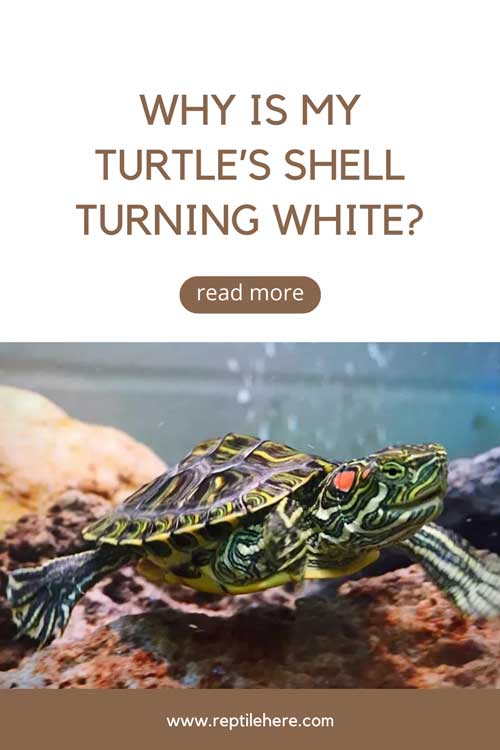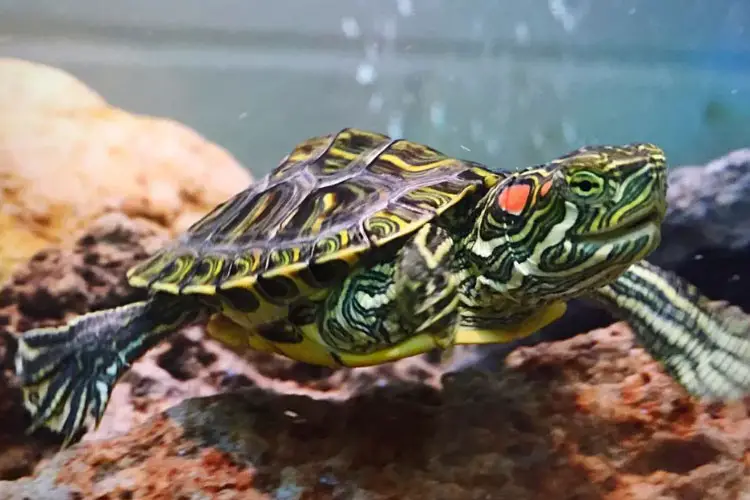Why Is My Turtle’s Shell Turning White?
If you have noticed your turtle’s shell turning white and have no idea why this is happening, you’re in the right place. Turtle’s shell featuring white spots isn’t something new among turtle owners. But what causes it and does it mean your turtle is sick?
Why is my turtle’s shell turning white? Your turtle’s shell turning white is usually due to hard water which has dried on the shell, leaving behind a chalky white residue. Other potential causes for turtle shell turning white include inadequate UV lighting, fungal infection, shedding of skin or scutes, and shell rot disease.
In this guide, you’ll discover more in-depth details on why your turtle’s shell has turned white or has developed white spots. You’ll learn how to fix this issue on your own plus other helpful information you need to know about turtle shell discoloration.
What does it mean when a turtle’s shell turns white?
Contents
Whenever you see your turtle shell starting to form white spots, it doesn’t always mean that your turtle is unwell and you shouldn’t panic! Instead, you should focus on uncovering what has caused the shell to turn white.
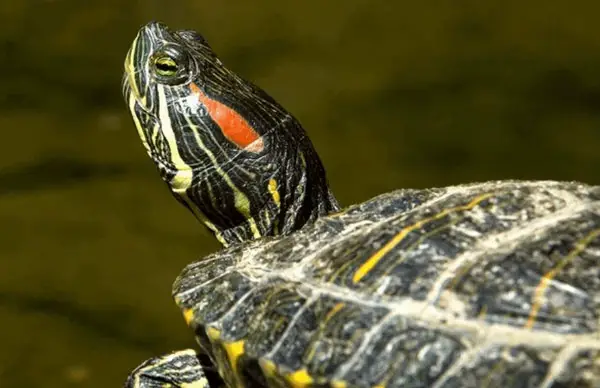
The most common reasons for the shell to develop a whitish appearance are listed below:
Hard water deposits
Hard water is the most common cause for your turtle shell to turn white. It usually happens if your turtle’s habitat has hard water.
This type of water makes forms an evenly coated white color. Or sometimes part of the shell, usually the bottom half, gets covered in bright white patches.
White spots from hard water also tend to occur in the raised ridges and ends of your turtle shell.
Luckily, the white spots do not cause any harm to your turtle and are easy to clean with just some gentle rubbing or scrubbing.
To confirm if the spots are indeed formed by hard water, apply some vinegar to the affected spot. If you see fizzing, you can rest assured that the cause of the shell whitening is hard water formed by calcium carbonate.
However, you should avoid using vinegar if there’s any moisture or irritation near the white spots as this can be painful for your pet. You should also avoid using vinegar near the turtle’s eyes.
Whitening caused by hard water will also cause your turtle to undergo some shedding and its scutes become more transparent as they continue peeling.
Solution: You can get rid of shell whitening caused by vinegar by creating an apple cider vinegar solution and gently applying it to its shell with the help of a soft toothbrush. Also, make sure you replace the current water with water treated using a conditioner or softener or even use distilled water to prevent more whitening.
Fungal infection
A turtle’s fungal infection can also cause your turtle’s shell to turn white. Typically, the infection manifests itself in form of green raised spots that are accompanied by fuzzy gray and white patches.
Fungal infections are usually a result of poor tank water parameters or poorly set up basking areas. It is best if you detected and treat this infection on time, otherwise, it can lead to further outbreaks.
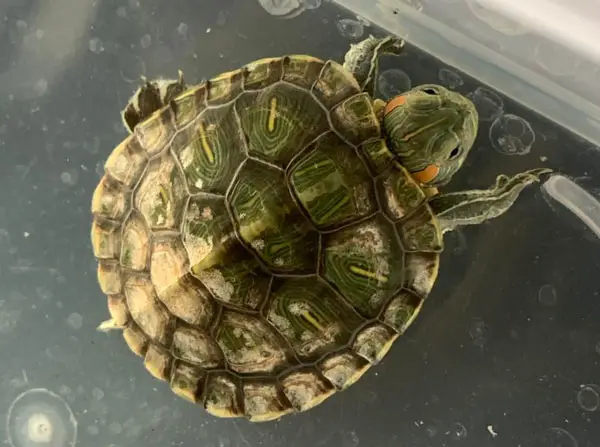
The good thing about turtle fungal infections is that you can treat them and even prevent them in the first place
Here are some proven ways of dealing with this type of infection:
Give your turtle a soap and iodine bath
Put your turtle in a bathtub or any other wide container and clean its shell with a solution of iodine and soap. Use fragrance-free, hypoallergenic soap and a Betadine solution for this process.
A soft bristles toothbrush would work best for cleaning the shell. In case your turtle has already developed injuries, you may want to avoid this treatment as it will cause more harm to your pet than good.
Salt bath against fungal infection
Giving your turtle a salt bath will also help stop fungal growth (fungi usually thrive in warm and wet enclosures).
Fill a spacious container with water and add bathing salt (every 5 gallons of water should go with a quarter of salt). Now transfer your turtle to this container and let it sit inside for 40-45 minutes.
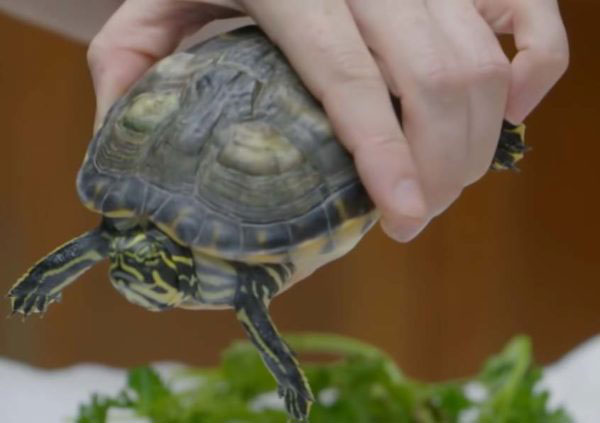
This bath will not only help eliminate the fungi but will also disinfect any punctures along the way. After the bath time is over, avoid patting dry your turtle; instead, let its body thoroughly soak in the solution.
Repeat this routine every day for up to 2 weeks to help keep away future infections.
Clean your turtle’s tank
As we have said above, dirty tank water is one of the causes of fungal infections.
Cleaning your tank regularly is one way to keep the water quality in check and significantly reduce the chances of fungal infections.
Be sure to observe partial and full water changes for your turtle tank, depending on the condition of the tank.
Inadequate UVB lighting
yes, not providing your turtle with adequate amounts of UV lighting will also cause it to develop white spots on its shell. The shell doesn’t show random white spots in this case, but you’ll see general fading on the usually dark-colored shell.
Shell whitening due to poor UV lighting is less common, but it’s still good to consider it as a potential cause. If your pet’s shell has been gradually dulling and losing its pigment, then it is most likely because the reptile isn’t getting sufficient UVB light.
You can solve this by getting a decent UV light bulb that gives out a decent amount of light to correct the problem. Additionally, you should ensure the basking area is properly set to ensure maximum absorption of UVB light for your turtle.
Shell rot
If your turtle is suffering from shell rot, it will also exhibit whitening. It creates bright white spots all over your turtle shell and these are also followed by leaking fluid.
You may also see pieces and bits of shell peeling off your pet depending on severity of the condition. The resulting wounds also tend to produce a bad odor.
Shell rot is a more serious condition and can even turn out to be life-threatening if not treated on time. If the bacteria causing the rot find their way into the animal’s bloodstream, it can lead to septicemia which can easily kill your turtle in a matter of days.

Poor tank environment, injuries, and cracks on the turtle shell are some of the major reasons leading to shell rot. You should take time to identify the potential cause of this problem and eliminate it, whether it’s dirty water, aggressive tank mates, sharp objects in the aquarium, etc.
Simply, mild shell rot cases can be treated at home. Just take the affected turtle from its tank and keep it off the water and dry it until it heals completely.
If your turtle’s condition doesn’t improve after 1-2 weeks, it’s time to take him/her to the vet to prevent the condition from getting worse.
What should you do if your turtle’s shell turns white?
If your turtle’s shell turns white, the first thing you need to do is try to identify the cause of the problem. As we have just seen above, the issue can be caused by environmental or medical factors.
Environmental factors such as hard water and insufficient UV lighting are usually easy to handle as they don’t cause any harm to your turtle.
You just need to remove the hard water deposit coating on your turtle’s shell and then do a water change as we explained earlier to prevent further whitening due to hard water.
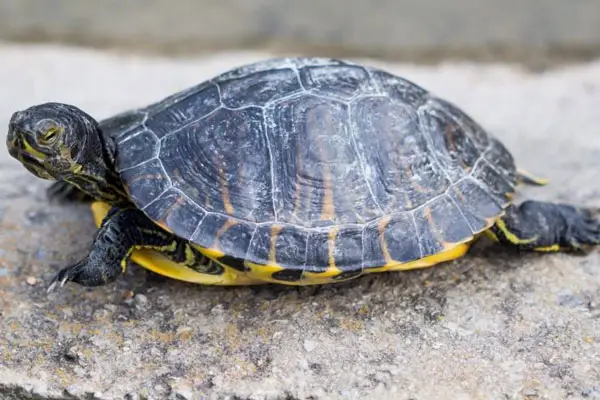
Medical conditions such as shell rot and fungal infection are more serious and need to be taken care of immediately.
If detected early, these conditions can be treated on time before they can get worse. We’ve already laid down information on how to go about each of these conditions in the previous section, so we won’t go into the details again.
What if the turtle shell turns white when dry?
The most common reason for your turtle shell turning white when dry is due to hard water deposits. As you may already know, hard water usually features a high concentration of minerals such as magnesium and calcium.
When your turtle is dry, the hard water dissipates and leaves behind a trace of minerals or a residue that’s whitish in color (as well as chalky).
You can test if the whitening is due to hard water by applying vinegar to one of the white spots. if you fizzing, then it’s hard water.
Lack of enough UV light, fungal infection, and shell rot may also cause the shell to appear white when dry. Before you jump to conclusions, it’s best to find out the cause of the shell whitening. This will give you a clue on how to go about the problem.
What do white spots on my baby turtle’s shell mean?
White spots on your baby turtle’s shell could be due to mineral deposits caused by hard water.
Such deposits are harmless and are easy to get off your turtle’s shell with just apple cider vinegar and a soft toothbrush.
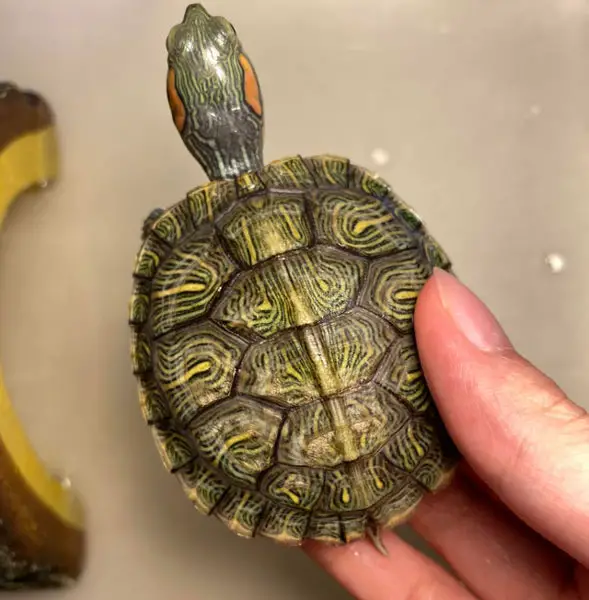
Just like their adult counterpart, baby turtles are also prone to fungal infection and shell rots which are other potential causes of shell whitening.
If you don’t provide your baby turtle with an appropriate basking area with adequate UV lighting, its shell may also show white spots.
Why does my turtle’s shell look ashy?
Your turtle shell looks ashy due to hard water deposits. Unhealthy levels of humidity in its surroundings and retained scutes due to improper shedding can also cause the shell to look ashy.
Lack of essential nutrients may also cause your turtle’s shell to appear ashy grey.
If the cause for this appearance is hard water, then it’s harmless to your pet and you have nothing to worry about.
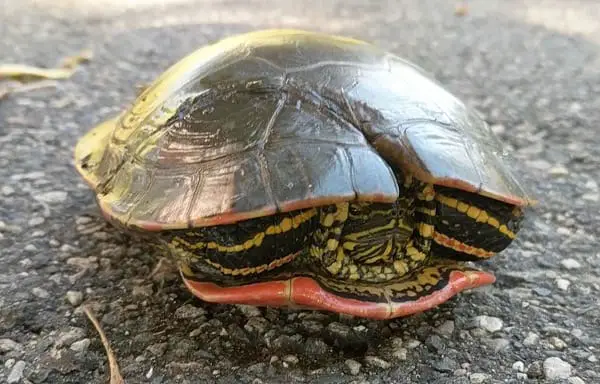
Otherwise, you should ensure your turtle has access to adequate UVB lighting which promotes healthy shell growth.
You should also feed your turtle a healthy, balanced diet that contains all the essential minerals and vitamins.
Related Questions:
To get rid of white spots on turtles, you first need to identify the cause behind them. As we have seen in the above guide, both environmental and medical factors can cause white spots. Knowing the specific reason behind the whitening will help you take the right action to get rid of the spots and prevent them from coming back.
The most common reason your red-eared slider shell is turning white is due to hard water in its tank, which leaves mineral deposits on its shell that is whitish and chalky. It could also be due to bacterial infection (which damages the shell), fungal infection, or simply lack enough UV lighting.
Final Verdict
Turtle shell turning white is a pretty common problem and may affect your turtle’s health. The major cause of this issue is hard water deposits which occur if your turtle tank has hard water. This is usually harmless and you can easily get rid of it by using vinegar.
Other causes of turtle shell whitening include fungal infection, shell rot, and lack of enough UV lighting. These are more serious issues and require vet intervention to ensure your turtle stays in good health. Shell rot in particular should be treated on time as it can kill your pet.
